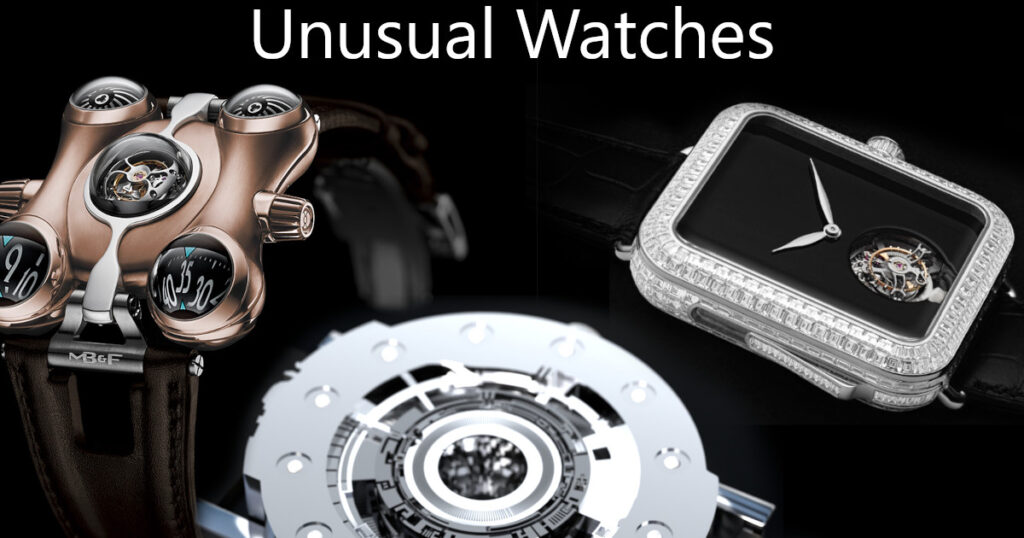
The watch in the centre of the above image, is our own Techno-circle #1.
Sections Of This Article
- What Makes A Watch Unusual?
- Unusual Watches And The Evolution Of Horology
- Reasons For Buying An Unusual Watch
- Marketing, And How It Relates To Unusual Watches
- Great Examples Of Unusual Watches, And Why Each Is Unusual
- Why Unconstrainedtime Watches Are Unusually Unusual
- My Answer To The Question Of Whether Unusual Watches Are Really More Common Now
Introduction
While it is obvious that timepieces which say they are “unusual watches”, are more common than ever, that’s not the whole story, because, as I’m sure is obvious, sometimes such statements are more about marketing than reality.
This article looks at the reality of unusual watches, the marketing, and the interesting relationship between the two, as well as looking at why you would want to buy an unusual watch, some great examples including our own very unique watches, then answer the question from the title of this article.
Note . . . I only use watch images with permission from the watchmaker (unless the photos are public domain or creative commons), so some of the watches I present here might be lacking an image.
What Makes A Watch Unusual?
The concept of “unusual” is somewhat related to exceptional, extraordinary, unique, and individual, and most strongly related to the concepts of rare and uncommon.
Indeed, one of the major reasons for a watch being un-usual would be its rarity, which often stems from limited production runs or unique design elements. Limited editions or discontinued models inherently acquire rarity due to their restricted availability. There are good and bad reasons for doing this, which I’ll explain below. Manufacturers may craft timepieces using unconventional materials such as meteorite dials (see below), exotic alloys, or rare gemstones, contributing to their scarcity.
Here is a beautiful example of a meteorite dial, on the Holthinrichs Deconstructed Meteorite:
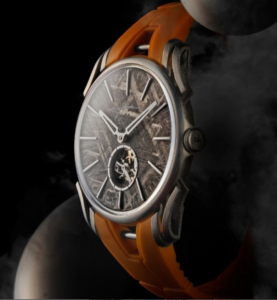
Some watches were made as a test, or a prototype. A watch can even be more valuable because it wasn’t popular when the model was released, so its rarity increases its value in retrospect, or even because errors in production make it unique. This also makes it a good idea to buy a watch for investment just as it goes out of production.
Unusual watches often push the boundaries of conventional design. Innovative complications beyond the typical hour and minute hands, like tourbillons, perpetual calendars, or minute repeaters, showcase extraordinary craftsmanship. I’ll go into more details of unusual design features, below. Uncommon case shapes, innovative materials (see below), or avant-garde designs can set a watch apart, appealing to collectors who invest in rare watches which are likely to increase in value.
Radical watch designs can focus mainly on unique aesthetics, primarily showcase impressive feats of engineering, or accomplish both.
Relationship to celebrities or history.
Historical significance greatly contributes to a watch’s uncommon status. Timepieces associated with significant celebrities or events, owned by notable figures, or embodying ground-breaking technological advancements become prized possessions. Vintage watches, especially those with a unique provenance or an association with a renowned maker, hold an inimitable allure. An example is the TAG Heuer Monaco Steve McQueen:
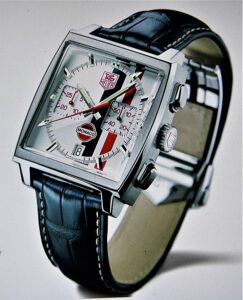
The dial of a vintage watch is especially important for its value. An original dial in good condition adds considerably to the value of an interesting watch from the past, although the condition of the rest of the watch is always significant also.
Exceptional craftsmanship and intricate detailing also define unusual watches. Handcrafted components, intricate engravings, or painstakingly decorated movements showcase the artisanal mastery behind each piece. Exquisite finishing, whether through hand-polished surfaces or intricate guilloché patterns, adds an unmatched touch of luxury and exclusivity. There are a few watches which are entirely handmade, such as watches by the legendary Philippe Dufour, and Roger W. Smith, a British watchmaker who creates ten hand made watches each year.
Collaborations.
Collaborations between watchmakers and other industries, such as automotive or aerospace, result in uncommon timepieces that blend design influences, or even engineering, from diverse fields, creating watches with distinctive features and unconventional designs.
An example is the Baume & Mercier Baume Ocean Limited Edition Automatic.:
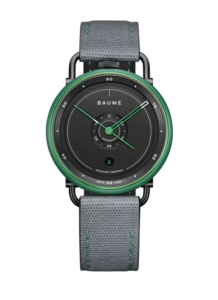
It combines collaboration with the NGO WFO (a historical partner of Baume) and the Seaqual initiative, aligns with the brand’s focus on eco-responsibility, and has a distinctive minimalistic design.
Another interesting area is collaborations between watchmakers and artists, resulting in watches with a unique story and unusual aesthetics. Some are even individually hand-painted (I’ll tell you about a great example of one of those, below), making each watch unique.
Collectors and enthusiasts alike seek exceptional timepieces not merely for their ability to tell the time, but for their inherent beauty, innovation, and the stories they encapsulate.
With the secondary market valuing many watches by the most sought-after current watchmakers above their retail value, and values fluctuating daily due to various factors, judging the future value of a watch is more challenging than ever. Unusual watches can become collectibles which increase in value before they have even left the factory.
Unusual watch features.
Watches, beyond their primary function of timekeeping, boast an array of extraordinary features that push the boundaries of innovation, craftsmanship, and design. These exceptional features redefine traditional horology, captivating enthusiasts with their ingenuity and uniqueness.
One of the most unusual and captivating features in watches is the tourbillon. Invented by Abraham-Louis Breguet in the late 18th century, the tourbillon aims to counter the effects of gravity on the accuracy of timekeeping by placing the escapement and balance wheel within a rotating cage. This mesmerizing complication is showcased prominently on the watch dial, often visible through an aperture, offering a captivating view of the intricate, constantly moving mechanism. Examples like the Breguet Classique Complications 5307 or the Greubel Forsey Quadruple Tourbillon demonstrate the pinnacle of tourbillon craftsmanship. Here is a closeup of a Stuhrling Tourbillon Movement:
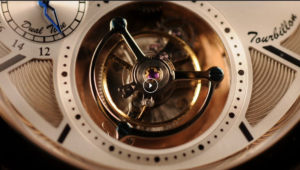
Another remarkable feature is the minute repeater, renowned for its ability to audibly chime the time on demand. It comprises a complex system of hammers and gongs that, when activated, produce a harmonious sequence of chimes to indicate the hours, quarter hours, and minutes. Watches like the Patek Philippe Grandmaster Chime or the Audemars Piguet Royal Oak Concept Supersonnerie showcase the exquisite artistry and technical prowess behind this complication.
Furthermore, perpetual calendars stand out for their ability to accurately display the date, day, month, and leap year without requiring manual adjustment for many years, sometimes even accounting for leap years. Brands like A. Lange & Söhne and Jaeger-LeCoultre produce watches with perpetual calendar complications, showcasing a harmonious blend of functionality and craftsmanship.
There are various watches with innovative and interesting time displays. An example is the Mr. Jones Watches Sun and Moon:
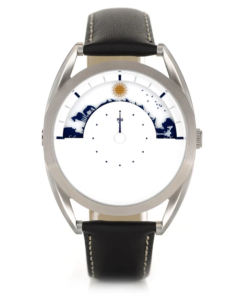
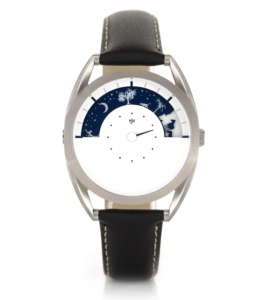
. . . which displays the time using a unique crescent shape, with sun or moon visible, indicating daylight or night time (above), as well as animal shapes at the times they would appear.
This interesting time-display concept was first used in the 17th Century, before watch hands and a dial with numerals around the edge became standard, and is beautifully revived for this elegant watch, with styling suitable for the timeless concept, unlike the modern aesthetics of most of their watches.
Our own UnconstrainedTime watches have a unique new time display as just one of their unusual aspects.
Other examples include the belt type time displays which are available from a few watches these days including a beautiful example below, and some radical digital displays, such as this example which allows it to be read by the blind:
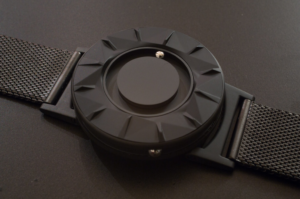
. . . can be read in complete darkness, thanks to a unique tactile time-display which uses two ball-bearings moved by magnets. The design is named after Brad Snyder, an ex naval-officer who lost his eyesight in an explosion in Afghanistan. He won a gold medal in swimming at the 2012 Paralympics in London, a year after losing his sight.
“I’m going to show people that I’m not going to let this beat me. I’m not going to let blindness build a brick wall around me. I am going to find a way forward.” -Brad Snyder
Another way a watch can be unusual is if it was designed in an uncommon way. Although some uses of computational tools in watchmaking are increasingly common, algorithmic design in watchmaking is still relatively new and is being used in some fascinating ways.
Watches incorporating unusual materials
In the world of horology, the use of unusual materials has become a hallmark of innovation and creativity, allowing watchmakers to transcend traditional boundaries and create timepieces that are both striking and technologically advanced.
One remarkable example is the utilization of forged carbon (which uses smaller pieces of carbon than woven carbon fibre allowing a greater range of shapes as well as increased strength), initially prominent in industries like aerospace and motorsports. This material, characterized by its lightweight yet robust nature, found its way into watchmaking, resulting in watches with exceptional durability and a distinctive marbled appearance. Brands like Audemars Piguet with their Royal Oak Offshore Carbon or Richard Mille’s RM 11-03 showcase the avant-garde use of forged carbon in luxury timepieces.
Another notable material is sapphire crystal, typically known for its use in watch crystals due to its scratch-resistant properties. However, advancements in technology have led to the production of transparent sapphire crystal cases, offering a captivating view of the intricate movement within. Watches like the Hublot Big Bang Unico Sapphire, the Romain Jerome Spacecraft or the Richard Mille RM 056 Sapphire demonstrate the exceptional transparency and strength of sapphire crystal in watchmaking.
An exceptionally unusual watch, featuring a unique use of sapphire crystal is the HM9 Sapphire Vision from MB&F:
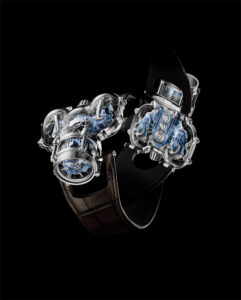
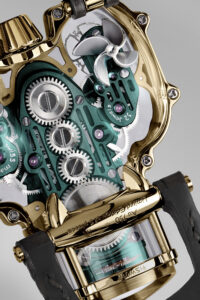
. . . which is visually extraordinary as well as being technically impressive, and was made available to the public in four limited editions, with just five pieces each. They decided to present their amazing and beautiful movement encased in “an outer hull of sapphire crystal and precious metal.” An outstanding example of an unusual watch, for several reasons.
The incorporation of unconventional alloys, such as high-tech ceramics, titanium, or even precious metals like gold alloys with specific properties, has enabled watchmakers to create timepieces that are not only visually stunning but also highly resistant to scratches, corrosion, and wear. These materials redefine the boundaries of traditional watchmaking, offering enthusiasts a glimpse into the future of innovative and resilient timepieces.
Unusual Watches And The Evolution Of Horology
Ground-breaking watches often set trends, which are then reflected to a lesser degree in other watches. One of the most significant examples of this is the Cartier Santos, designed In 1904, for pioneering Brazilian aviator Alberto Santos-Dumont who needed to be able to see his watch without letting go of the controls with his hands in order to time his performances. He asked Cartier to create a watch for his needs. Cartier designed it to be worn on the left wrist, with what are now called lugs to hold the strap to the case and a clasp to hold it firmly (unlike a slip-on women’s bracelet), a winding mechanism on the right, and a minute hand. They named the model the “Santos”:
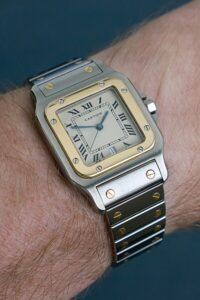
. . . and it has been the basis of the majority of wristwatch designs since that time, although it was very unusual at the time.
Unusual watches, characterized by their innovative features, unconventional designs, and rare complications, play a pivotal role in propelling the evolution of timepieces. They serve as avant-garde symbols, pushing the boundaries of traditional watchmaking and influencing the trajectory of the industry in several impactful ways. Or to put it another way, any significantly revolutionary watch, is, in its own time, unusual, by definition.
Firstly, these extraordinary watches act as catalysts for technological advancement within the horological realm. Unusual timepieces often introduce cutting-edge complications and mechanisms that challenge conventional limitations. Innovations like the tourbillon, minute repeater, and perpetual calendar, initially featured in extraordinary watches, gradually make their way into mainstream production, enhancing the sophistication and functionality of more accessible timepieces. An example is the Patek Philippe cronografo calendario perpetuo ref. 2499:
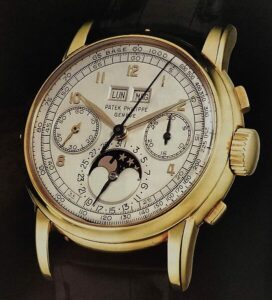
These watches often become testbeds for experimental materials and manufacturing techniques. The exploration of unique materials like carbon fibre, sapphire crystal, or innovative alloys initially showcased in uncommon watches eventually finds its way into mass-produced models, contributing to enhanced durability, aesthetics, and performance across the industry.
Unusual watches also drive the industry’s design evolution. Their daring and unconventional aesthetics, be it through peculiar case shapes, non-traditional displays, or avant-garde complications, inspire other brands to push the envelope in design.
Even the 7-segment time display, used in most digital watches, brought with it significant space-age and electronics aesthetics, which can be seen to have also influenced some unusual watches.
Furthermore, these innovative watches play a crucial role in redefining luxury and exclusivity. Their limited availability, unique complications, and artistic expression set them apart as coveted collector’s items. This exclusivity and desirability drives innovation and creativity among watchmakers, as they aim to create increasingly exceptional and rare timepieces to cater to the desires of discerning collectors, especially in today’s market where uniqueness is more sought-after than ever.
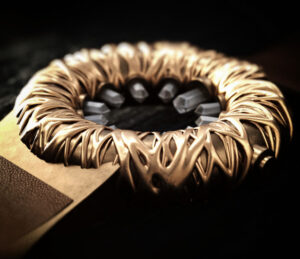
Unusual watches also help to shape consumer preferences and perceptions, influencing the evolution of watches. They challenge the notion of what a watch should be (as does, for example, our Tropical Crystal watch, above), encouraging enthusiasts to appreciate the artistry, innovation, and craftsmanship behind these extraordinary timepieces. This shift in perception fosters a greater appreciation for the heritage and complexities of watchmaking, leading consumers to seek more than just functional timepieces but also pieces that tell a story and evoke emotions.
The rise of unusual watches has spurred collaborations between watchmakers and other industries. These collaborations not only bring fresh perspectives to watch design but also attract new audiences to the world of haute horlogerie, contributing to the expansion and diversification of the market.
Some of the best of the contemporary watchmaking individuals are included in our blog post on individuality and watchmaking.
Reasons For Buying An Unusual Watch
Purchasing an unusual watch is often driven by various compelling reasons that transcend mere timekeeping. The allure of exclusivity and rarity draws collectors and enthusiasts to these timepieces. Unusual watches, with limited production runs or unique design elements, offer a sense of prestige and uniqueness that appeals to individuals seeking something distinctive and rare, as well as often being a good investment: “Limited edition watches are one of the few types of timepiece that are almost certain to increase in value” (Investing in Watches: Dos and Don’ts, Neamh Mcmillan, October 27, 2022)
Timepieces showcase cutting-edge technology, unconventional materials, and intricate complications, appeal to those fascinated by the artistry and technical mastery behind watchmaking.
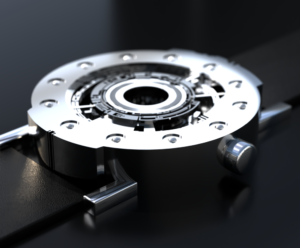
Furthermore, some individuals are drawn to unusual watches for their avant-garde designs and unconventional aesthetics (such as those in our Techno Circle #1 watch, above). These timepieces challenge traditional norms, offering bold, distinctive styles that stand out as statements of personal taste and individuality. The acquisition of an unusual watch becomes a form of self-expression, allowing wearers to showcase their distinctiveness and appreciation for unconventional beauty with what, in essence, becomes a piece of functional jewellery.
And of course, there’s nothing wrong with buying an unusual watch just because you love it, even if you don’t know why.
Marketing, And How It Relates To Unusual Watches
Marketing plays a pivotal role in shaping the perception of watches, often amplifying their uniqueness and distinctiveness to create allure and desirability among consumers.
With one of the desires of the current market being uniqueness, there is a lot of watch marketing aimed at making watches seem unusual, and there are several ways in which marketing contributes to making watches seem more unusual than they might actually be.
Firstly, storytelling and branding techniques are employed to create a narrative around a watch, emphasizing its heritage, craftsmanship, and exclusivity. Brands craft compelling stories that highlight the intricate details, innovative features, or historical significance of a timepiece, adding an aura of uniqueness and value.
Limited editions or special collections are strategically marketed to create a perception of scarcity and rarity. Even if the differences between models are minimal, the marketing campaigns emphasize their exclusivity, making them appear more exceptional and desirable. While limited editions made for good reason are understandably well loved by collectors and enthusiasts, when a brand releases a limited edition which is, for example, just a regular watch with a different coloured dial, those kinds of marketing ploys are, rightly, frowned upon . . . I go into more detail about the love/hate relationship with limited editions, here.
Strategic partnerships or collaborations with influential figures or other industries create a halo effect, associating the watch with prestige and uniqueness by extension. While some examples of these partnerships or collaborations are interesting, there are some watches associated with super-car brands, for example, which don’t do anything much other than add the super-car brand logo to an otherwise ordinary watch.
Many watches these days are marketed as “world’s first”. While there can be genuinely interesting examples, this tactic is rather over-used currently, and, like limited editions, some of them are only really a very minor innovation.
An example of a watch with very good reasons for being a limited edition, is the A. Lange & Söhne tourbograph perpetual, “pour le mérite”:
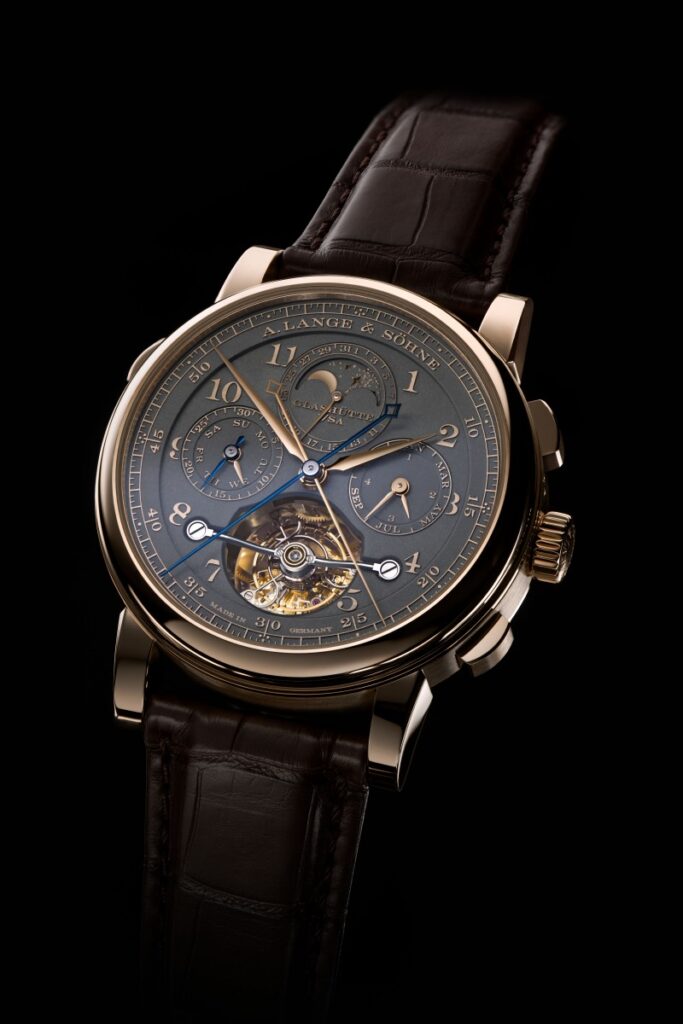
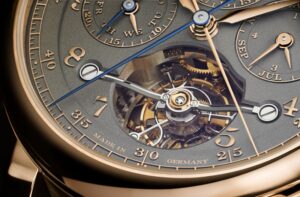
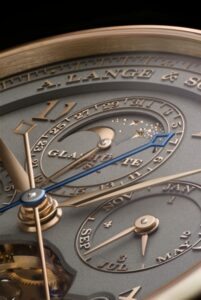
. . . which combines five outstanding complications: fusée-and-chain transmission, tourbillon, rattrapante chronograph, and perpetual calendar. It is available on “honey-gold”, silver or platinum, and limited to 50 pieces, commemorating their 175th anniversary.
Marketing often employs language and imagery that accentuate the extraordinary aspects of a watch. Advertisements and promotional material use phrases like “revolutionary design,” “innovative technology,” or “limited edition,” contributing to the perception of exceptionalism, even if the actual differences might be marginal.
Ultimately, while marketing can enhance the perception of a watch’s uniqueness, consumers should critically evaluate the actual features and attributes of a timepiece to make informed purchase decisions, rather than just believing the marketing hype. So make sure you see the marketing hype for what it is, and really think for yourself about what is genuinely interesting, to you personally, about a specific unusual watch.
You might also be interested in the fascinating question . . . “Are watches art?“
Great Examples Of Unusual Watches, And Why Each Is Unusual
Here are some great examples of unusual watches, each noteworthy for its unique qualities:
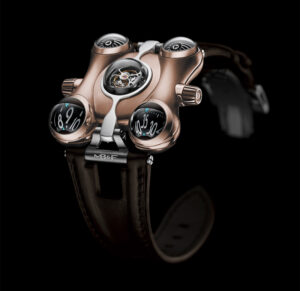
The HM6 Space Pirate by MB&F embodies a futuristic and unconventional design reminiscent of a spacecraft. Its sapphire crystal domes house the hours and minutes, with turbines that regulate the winding system. The unusual aspect lies in its intricate and otherworldly appearance, drawing inspiration from science fiction and pushing the boundaries of watch design.
For other examples of watches from the above brand, as well as some additional interesting examples, see our blog post section on innovative British watch brands.
The Arthur Oskar Stampfli – The Wheels of Time uses a radical time-display based on the concept of Tibetan prayer wheels. The time is shown by numerals on independent moving hour and minute cylinders, within a bracelet shaped case.
The Hublot Classic Fusion Takashi Murakami Sapphire Rainbow:
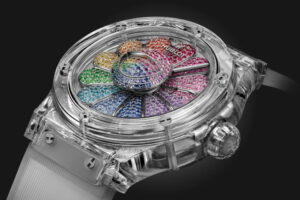
. . . adds a colourful element to this beautiful collaboration. They say “This new watch takes the smiling flower, the iconic theme of the Japanese artist’s work, and transforms it into a whirlwind of transparency and colour“
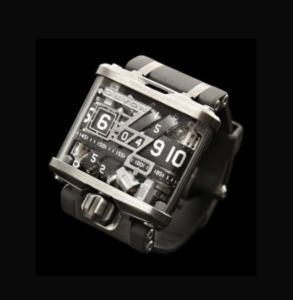
The Devon Tread 1 is an exceptional timepiece distinguished by its use of belts to display time rather than traditional hands. Its complex movement utilizes motorized belts to indicate hours, minutes, and seconds, creating a visually stunning and unconventional way of displaying time.
HYT watches:
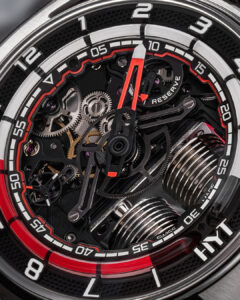
These unique watches diverge from traditional timekeeping by incorporating a fluidic time display. It features a bellows system that uses two liquids, one coloured and one transparent, to indicate the hours via a capillary tube. This innovative hydraulic technology results in a unique time display, marrying traditional mechanics with fluid dynamics.
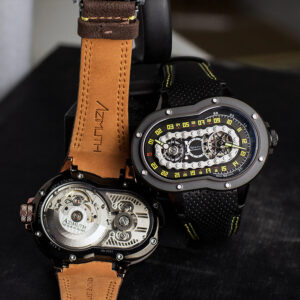
. . . proudly displays a unique chain transmission design concept. Its unusual case made to resemble a motorcycle engine, is asymmetrical, and also somewhat resembles the infinity symbol.
The Roger Dubuis Excalibur Automatic Skeleton in Carbon RDDBEX:
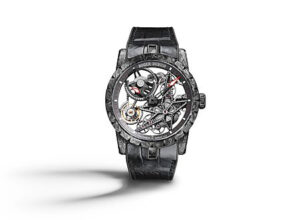
It includes the skeleton flying tourbillon which is Roger Dubuis’ core specialty, and is made of multi-layer carbon allows this watch to be ultra light at a mere 7.52g. It has an impressive power reserve of 90 hours.
The Breitling Emergency:
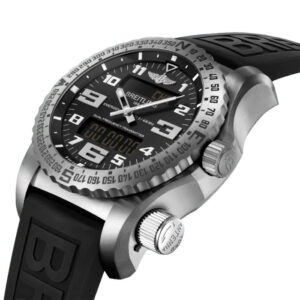
The Breitling Emergency is an exceptional watch renowned for its built-in dual-frequency distress beacon, making it a great choice for safety and survival for adventurers. When activated, the distress beacon will emit an alert signal that will guide rescuers.
The MING LW01
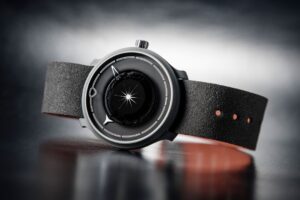
. . . said (at the time of writing) to be the world’s lightest mechanical watch, boasts an impressive weight of just 8.8 grams (0.31 ounces) for the manual variant, as well as having strikingly unusual aesthetics. It uses a high performance Magnesium alloy, an unusual glass, and hollow 3D printing, as well as unique designs. Even the screws are optimized for weight as well as performance.
The Christopher Ward C9 Moonphase:
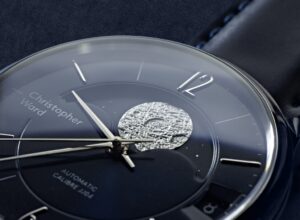
This watch stands out for its sophisticated moon phase complication. What makes it unusual is its exceptional accuracy in displaying the lunar cycle. This timepiece offers a remarkably detailed and precise depiction of the moon’s phases, adding a celestial and poetic touch to traditional timekeeping, as requested by their customers. They say “If you keep the watch fully wound it follows the moon in real-time for 128 years, whereas most other moon-phase watches are only accurate once a day.”
The Diatom watches, Blue Dot is the ultimate space watch that has actually been to space! “All of our watches are flown in space on board a custom carbon fibre craft.” They also say “We sourced metal from a space flown Apollo command module to incorporate into an orbiting ring at 6 o’clock“ as well as using a piece of meteorite on each watch.
The H. Moser & Cie Swiss Alp Watch Concept Black:
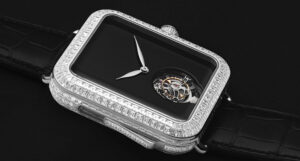
This watch challenges the digital age by imitating the appearance of a certain rectangular so-called “smart watch”. Despite its analogue movement, it looks like a digital smartwatch at first glance, yet is actually a mechanical watch, featuring a minute repeater and a flying tourbillon at 6 o’clock. This unconventional approach is an ironic commentary on the proliferation of digital devices and a testament to the brand’s dedication to traditional watchmaking.
The Jacob & Co. Astronomia Sky:
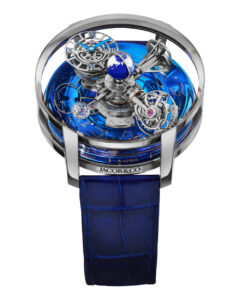
. . . is an extraordinary watch with a celestial theme. Its three-dimensional design showcases a miniature rotating globe, flying tourbillon, and a celestial dial displaying the constellations. This watch’s uniqueness lies in its extravagant and visually captivating representation of the cosmos on the wrist.
The A. Lange & Söhne Zeitwerk:
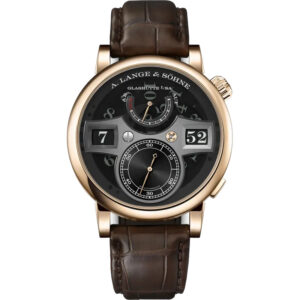
The A. Lange & Söhne Zeitwerk showcases an unusual and innovative digital time display. Departing from traditional hands, it features jumping numerals that indicate the time via rotating discs. This exceptional design reinterprets timekeeping in a bold and distinctive manner. Its ingenious digital display concept with traditional aesthetics set it apart from the multitude of analogue mechanical watches.
The MB&F HM4 Thunderbolt:
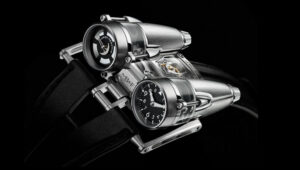
The HM4 Thunderbolt by MB&F is an extraordinary watch. The makers took three years to develop it, with all of the parts being unique to this model only. Its unusual feature lies in its highly unconventional and aerodynamic case design, reminiscent of a jet engine, using grade 5 titanium and sapphire crystal. This timepiece embodies MB&F’s dedication to avant-garde horology and unconventional aesthetics.
The Mr. Jones Last Laugh Tattoo:

The Last Laugh Tattoo by Mr. Jones is an unusual watch characterized by its whimsical and unconventional design which is linked to the tradition of memento mori, reminding you that life is brief and you should live it to the full. It features a skull that indicates the hours and minutes with its teeth. Its playful and distinctive appearance challenges traditional watch design with a touch of humour.
The Richard Mille RM 27-01 Tourbillon Rafael Nadal: is remarkable for its extreme shock resistance, designed specifically for tennis player Rafael Nadal. Its unusual feature is the suspension mechanism that holds the movement within the case using four braided steel cables, ensuring durability and shock absorption against the intense movements of professional sports.

This beautiful watch, part of their Deconstructed line, is unusual for several reasons. It has a genuine piece of Muonionalusta meteorite for a dial. It has an open-printed case with sculpted hollow lugs and a recessed case-band carrying the brand’s logo and the creator’s signature 3D printed in grade 5 titanium, and proudly showing the unique 3D printing texture on some of the parts.
The Xeric Soloscope II Automatic:
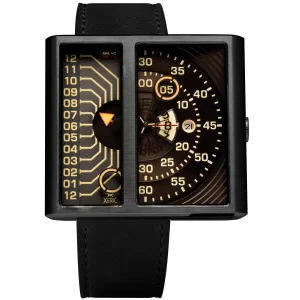
This unusual and interesting watch has a halo hand which encircles the minutes, with an additional left-hand side which is an AM/PM indicator and can alternatively be used to read the hours. It glows effectively for night-time indication.
The collaborative watch Parmigiani Fleurier and Marcello Lo Giudice, (no longer showing on their website) featuring work by Italian contemporary painter and sculptor from Sicily. His tactile paintings use thick layers of pigment and evoke geological formations, shown to great effect on this watch. This is a great example of a collaboration between an artist and a watchmaker making a watch very unusual, because art is, by definition, unique (compared to design, which is often mass-produced).
The Bremont Ronnie Wood 1947 Rock On’ Hands Down 43mm Men’s Watch was released in 47 pieces, as a tribute to Ronnie Wood, the Rolling Stones’ guitarist, who was born in 1947. He hand-painted every dial himself, making each one a totally unique collectors item.
These examples represent the pinnacle of unusual watchmaking, each pushing boundaries in design, technology, or materials. They challenge conventions, offering enthusiasts a glimpse into the innovative and creative possibilities within the world of haute horlogerie.
Which brings us to . . .
Why Unconstrainedtime Watches Are Unusually Unusual
You can see by looking at our watches that they are more unusual than most timepieces. If you understand the concepts that UnconstrainedTime watches relate to, you’ll understand why I say that we are arguably the first conceptual art jewellery based watch brand.
If you like our watches, don’t miss the launch . . . subscribe for email notifications.
A major reason that the watches I’ve created are unusually unusual is that I am starting from a different background to other watchmakers. I have no training in watchmaking and a lot of traditional watches don’t appeal to my aesthetic tastes. My background is fine art and cutting-edge contemporary music, and it was only after I’d created my unique watches that I happily discovered that they align with the microbrand enthusiast’s love of uniqueness and creativity.
I’ve shown in this article, the Parmigiani Fleurier and Marcello Lo Giudice watch, as an example of how art, being itself unique by definition, confers uniqueness to watches when an artist collaborates with a watchmaker. There are many beautiful examples of collaborations between artists and watchmakers on our blog post here, which result in a watch with some art in it or on it. If you looked at such a watch itself without any of the added art and colour influences, I don’t think the watch would remind you of the art, to any significant extent.
By contrast, UnconstrainedTime isn’t a collaboration between an artist and a watchmaker, and our watches are not an otherwise conventional watch with some art in it or on it. With our watches, the art and the watch are not separate elements of a collaboration: the watch itself is the art, and the piece of art is the watch itself. Even with the watch we’re launching our brand with, our Fractal Emergence 40mm:

. . . where the 3D fractal can be seen as a partially distinct structure, the rest of the watch wouldn’t have an aesthetic purpose without the fractal, and has specifically created simple, simple qualities to focus the attention on the beauty and wonder of the fractal. We’ve not taken a standard watch design and added a fractal to it, the fractal and the watch make sense of each other . . . for example, the rest of the watch is all curved, because there are no straight lines or sharply pointed angles in the fractal.
It’s also almost certainly the first 3D fractal watch ever made, which we’re launching with in 2025 . . .
Don’t miss our launch!
. . . make sure you subscribe to our Priority List for notifications.
My Answer To The Question Of Whether Unusual Watches Are Really More Common Now:
So we’ve looked at what really makes a watch unusual, as well as why marketing sometimes exaggerates how unusual a watch might be.
Overall, my answer is . . . yes, there are more unusual watches than ever, even if you discount the marketing exaggerations such as limited editions that are just a change in dial colour on an otherwise standard watch . . . and the reason is what’s behind the desire for uniqueness in today’s watch market, which is the increase in uniqueness and the desire to be different within society in general.
What do you think? Do you think there are more unusual watches than ever before? Comment below or on our social media.
Author: Chris Melchior

This article was authored by Chris Melchior, founder of UnconstrainedTime and creator of the original range of wrist-worn sculptures of this unique artistic adventure.
Chris has extensive knowledge and experience of creativity, including fine art and cutting-edge contemporary music composition, and was awarded a First Class Honours Degree in fine art and music with a minor in philosophy.
Chris’s life-long artistic obsessions include organic forms and textures, abstraction, fractals, and the aesthetic essence of musical genres.
He has developed unusually deep insights into the elemental concepts underlying areas including Eastern and Western philosophies, science and technology, creativity and the arts, as well as empirical spirituality in which he is acknowledged as a leading authority.
He has a profound fascination and love for the unique and synergistically creative combination of fine art with the ancient essence of time-keeping which evolved into the UnconstrainedTime project.

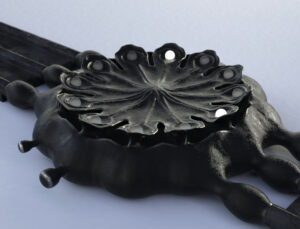
Leave a Reply